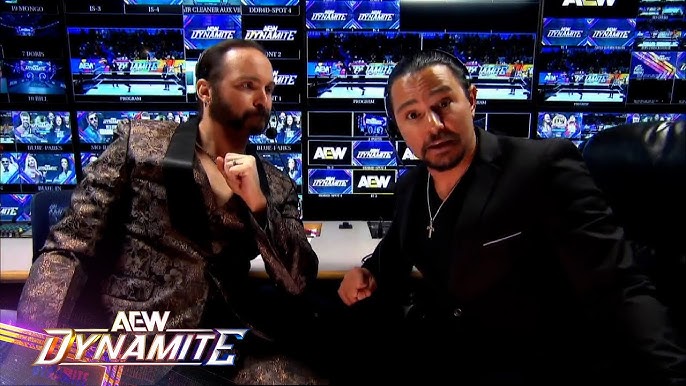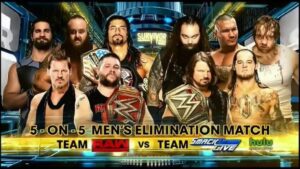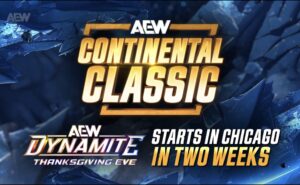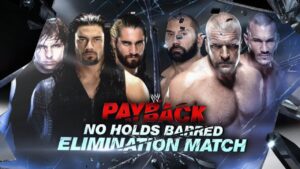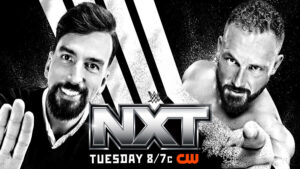Earlier this year, James wrote a deep dive of AEW’s first five years. Months later, this epilogue, written the day before the fifth anniversary of Dynamite is an exploration of how perceptions towards AEW have changed and why despite its flaws, he keeps watching.
Hi, I’m James and I’m an AEW fan
I’m not ashamed to be a pro wrestling fan. I tell both colleagues and my teenage students (the most judgemental of human beings).
I’m fine dealing with their curiosity and dismissal. Knowing someone, seeing their face, and hearing the tone of their voice makes it easier to have healthy dialogue.
Things that are hard online. Declaring you’re an AEW fan online has felt like declaring your political allegiance.
It seems to signal to some that you’re an open target for a character assassination based on stereotypes. The general principle seems to be that criticism is fine because you’re one of those “fans” who constantly attack “my tribe”.
It is as if I’m part of some cult that set out to “bully” other fans or celebrities like Kat Dennings for preferring WWE. It’s depersonalizing and thoughtlessly easy, and something some AEW fans can and are just as guilty of encouraging and giving back.
But, in the last year, the narratives and type of dismissal that myself and others have received for liking the alternative come back to the shifting perception. Many don’t feel that the alternative isn’t what they want/need.
A wider sense of declinism, the belief that AEW is in decline and things are/will only get worse, seems rampant. Accepted for various factors.
The past was better. The honeymoon is over.
Yes. The last is true.
Some things have been lost. Some aspects of early AEW won’t come back.
AEW is flawed. That shift however was inevitable.
We Had High Hopes
I missed the Monday Night Wars. Actually, I’d shunned the over-the-top Attitude Era as “fake”.
What headlocked me for life was the Ruthless Aggression Era. SmackDown post–WrestleMania XIX and its blend of athleticism and storytelling.
But, over time, the monopoly of WWE and its increasingly lacking logic and stagnant creativity became alienating. Then actively willing fans to give up.
So, I did. Profits were hitting record levels.
No reason for the company to change. By the time I left university, I was a wrestling fan in habit rather than spirit.
Vince Russo had car-crashed my interest in TNA Wrestling. Hulk Hogan and Eric Bischoff took what was left for scrap metal.
I watched NJPW and ROH. Both are good but hard to access in the UK, which was a barrier.
Also, the balance of storytelling to wrestling wasn’t right for me. I, like many others, wanted (even fantasy booked) an alternative different from those others at the time.
What other real alternatives lacked as a catalyst to compete with WWE was two-fold. Knowledgeability and passion for wrestling and the funds to compete on WWE’s level.
Tony Khan became that unicorn. Something that, for a decade-plus, seemed mythical and too real to be true.
We dreamed of an alternative. Some, however, wanted something different.
Some just wanted WWE to be better again. No shame or shade in that.
However, those who want AEW to perish like WCW forget what happened afterward. For others, like me, we had our own specific ideas of what good wrestling should be.
Yet, even the broadness of being “not like WWE” on a large scale, has proved hard to achieve.
WWE’s Shadow
Whether you are a fan or not of WWE, the promotion has shaped the mainstream definition of pro wrestling. It touches all our fandoms whether we like it or not.
If not, it has led to the desire to not see AEW become WWE-like. A criticism that, at times, has been fair.
WWE has conditioned many of us to view wrestling in a particular way. Wrestling history has actively and passively been revised by WWE’s dominance, longevity, and mechanisms.
On purpose and just due to the long association that WWE is wrestling. Various tropes and aspects of wrestling that existed prior to or outside of WWE are seen as belonging to the company.
The WWE mindset likewise impacts how some even view the idea of competition in wrestling and ignore or excuse the company’s own similar errors. It has created myths and distortions like the concept of overpaying talent.
Or shadows the mistakes that the competition was not able to get under control. Like the idea, the inmates run the asylum in AEW like WCW.
Never an issue in WWE. Oh, wait… The Kliq in the early 1990s, whose political influence allegedly impacted the careers of Bam Bam Bigelow, Chris Candido, Shane Douglas, and others.
The Montreal Screwjob became something WWE capitalized upon and revised from a black stain into a dramatic turning point. As for backstage fights, Larry lost some teeth but Dynamite Kid lost a mouthful.
Shawn Michaels and Bret Hart pulled hair in 1997. There were various fights throughout the 2000s.
Chris Jericho/Goldberg. Booker T/Batista. In the 2010s, Sin Cara fought numerous colleagues.
Different justifications are used. Mainly WWE is still here.
So is AEW. However, like those other promotions, AEW in the short-term is judged differently.
Partly due to what Tony Khan said.
Promises
AEW made many promises as it began. Many were kept.
Some significant ones were broken. In July 2024, the WhatCulture crew did a comprehensive breakdown of each here.
Their discussion pointed out something that some begrudging fans ignore. Those ideas had yet to be tested in reality.
Plans never survive contact with the enemy. Things that sound great don’t work in principle.
Even something like the ranking system that has pros and cons creates long-term structural difficulties to maintain. Significant aspects AEW promised, like a real sports feel are half-fulfilled.
Ridiculous storylines happened. The focus on parity for the women’s division doesn’t even seem a priority on Dynamite.
WWE has let the fans down at various points in its history. But as I’ve written before, WWE survives and is successful and the old guard appears to be gone.
It’s weathered brown storms, even at the government level. It seems Teflon.
And unlike AEW, WWE never made promises built on “honesty and integrity” (Tony Khan on Talk is Jericho). Such promises seemed to sell AEW from the start as almost a utopian alternative to WWE where business would be done differently.
Utopia, however, is a sales pitch. Its origins translate to “no place”.
Making promises that could not be kept or inevitably had to change due to the reality being different to the idea set up AEW to fail to an extent. Creatively and ethically promises were broken.
Like WWE Would Do
AEW has been criticized for not managing things well like WWE. “Brawl Out” has been compared by some to Montreal, and the company has failed to fully move on or capitalize. This is especially shown with The Elite in 2023 and even now with The Corporate Turn.
Others, on the other hand, when AEW has acted like WWE, it feels extremely hypocritical. Like the recent reports of AEW’s refusal to release The Lucha Bros.
It’s the same playbook tactic WWE used with PAC and Brodie Lee. One can do it.
The other can’t because it’s not supposed to act that way. AEW made that rod for its own back to an extent.
However, controversy sticks to AEW as opposed to WWE. Partly due to the company’s infrastructure (PR and legal teams) and cultural significance and having weathered many storms.
There is somewhat the expectation also that, like other alternatives, AEW will mess up. It has happened before.
Just Like Other Alternatives
With AEW, comparisons to the past center on WCW. Beyond the Georgia promotion, the idea of decline is an easy conclusion given the past.
Many like XWF failed to get off the ground. Others like TNA, NJPW, and ROH peaked with their infrastructure, and broadcast availability created a ceiling.
Others like MLW or NWA exist at their own level. The same seems clear for AEW.
There are metrics to prove decline (ratings; attendance and general IWC perception). However, others that show financial growth get ignored for the simplicity of the narrative.
The new TV rights deal and a potential deal with FOX (SmackDown’s former home) suggest, in the short-term, that business is good despite issues with the traditional ways AEW is failing as a promotion (attendance, ratings). Unlike WWE which has cycles of boom and bust, alternatives just seem to be stagnant after the first impressions.
TNA, at various spots, with management changes. Some blame Jim Cornette for running ROH.
It’s natural that the booker gets the blame when things are bad. Alfred Konuwa of Forbes is right to suggest AEW could become like TNA and ROH – become “the living dead” and stagnant – but narrow-minded to assume there isn’t a middle-ground.
In the age of quick judgments, many have decided on facts ahead of time. And why not?
There are some historic patterns. Ignoring of course WWE’s own falling attendance and ratings from a decade ago.
For some fans, it seems a self-fulfilling prophecy that AEW will repeat history.
Framework and Story
The range of criticism AEW receives could be placed on a spectrum of valid criticism and nonsensical. Almost every aspect of AEW’s decision-making can be scrutinized.
Take the complaints about the 20-minute time limit stipulation for the AEW title vs. title match between Bryan Danielson and Kazuchika Okada. Filter out the categories of bad faith and AEW defenders who fit Jesse Colling’s 9 people that ruin discussion of AEW.
Remove those who wrongly assert cliché about pleasing Meltzer for the ratings, despite evidence that top AEW stars don’t care about match ratings or Meltzer’s consistent criticism of AEW’s creativity or business. It leaves noticeably two distinct generalizations, as well as one huge absurdity correlation.
First is the issue of logic. This varies from the business logic of how these choices help ratings/attendance/revenue down to the artistic aspects of storytelling.
Even when expressed with bad faith, bad logic, and poor inarticulation, there is a valid point. However, AEW doesn’t tell stories, as I’ve discussed elsewhere in this series, which is moronic when the company’s entire framework reinforces the overarching story that everyone is competing to be the best.
I’ve been told it’s not a story or device by multiple folks echoing grifters who don’t seem to acknowledge how overarching of a story structure this is in popular culture. Being the very best is literally the wider plot of the Pokémon anime series and video game franchise I loved as a kid.
Plus, various fighting video games. Pretty much every boxing and sports movie.
Or the implicit reason for drama in real sports leagues and competitions. The framework, sometimes, is expected to do the heavy lifting in place of characterization, relationships, and subplots.
All things AEW has but…
Logic Issues – Inconsistency and Ownership
The biggest difference with WWE is the formula is less rigid, more chaotic, and rotational in terms of both cast and at times tropes/directions. WWE shows have a set structure.
There are set expectations that are consistently fulfilled. AEW does to the extent of strong ring-in action, built around the framework it’s a show about wrestlers wrestling.
WWE is a show where wrestling is the outcome. Both companies use variety.
WWE is more story-based and balances in-ring with comedy, drama, skits, and explicit soap operas. AEW’s variety comes in offering a buffet in terms of what happens in the ring and more varied means of building those matches.
The issue isn’t in not telling stories but, in doing so consistently, clearly, or cleanly. AEW used Easter Eggs before WWE made it cool during The Elite Saga.
I’d argue that “Hangman” Adam Page, in both his anxiety arc and relapse arc, perfects symbolism. Why this worked was week to week consistent.
Something that is lacking with the rotational roster system the promotion currently uses. Too many wrestlers and too many stories.
And, unlike WWE, AEW doesn’t reinforce and remind viewers of what the story is with week-to-week long promos and monologues, recap packages, commentary reminding you, etc. They expect/assume fans to pay attention.
Sometimes giving us, as fans, too much credit. Expecting us to remember months of drama and development across multiple shows.
Sometimes AEW gives fans too much ownership. And more recently AEW, like WWE has bent logic to fit the narrative.
As I’ve talked about elsewhere in this series.
Connective Tissue
The lack of connective tissue sometimes is a problem. Let’s go back to Danielson vs. Okada III again.
It’s valid that the only build is a graphic and a promise of a banger. Without disrespect, a casual fan may not have either the prior knowledge or the right mindset to understand the implicit story that is not being told or sold loudly.
I can get the expectation that there should be more. Given the magnitude of that this is two of the GOATs competing together on one of the most significant shows in AEW.
And, while it promises a banger match, I would not be surprised if it ended in a WWE-style DQ to protect Okada.
Which is a problem of AEW’s buffet style. Not everyone is fed equally.
Broad USP Doesn’t Get Everyone
The second part of valid AEW criticism comes from an inability to define the promotion’s style. Back to Danielson vs. Okada, one commenter said all that needed to be added was a pole to match stipulation to truly expose the Russo-like booking.
Yet, when I think of Russo booking, I think of over-the-top crash TV angles. Short matches, not a teased twenty-minute clinics.
Gaga over graps. Wrestling in-ring seemed to bore Russo.
AEW is accused of being too much for the hardcores. It’s too much like a WWE clone.
Too wrestling-centric, too Russo-like, too indy. Way too violent.
Way to boring. A lot of those critiques contradict each other.
All those things cannot be true at once. Well, it can, to the extent that AEW’s USP is wrestling first, in theory and mostly practice.
Yet, “sports entertainment” since day one has always featured. The first AEW champion in Chris Jericho somewhat represented the threat of McMahonism.
Built to be defeated by the embodiment of the alternative, Jon Moxley. It worked because of that dynamic and unhappiness with WWE.
This changed when The Paul Levesque Era began. Too much of sports-entertainment drew criticism during MJF’s championship run.
It remains a sticking point a worry for some because some angles and some wrestlers’ in their presentation are sports entertainment based. Mixed alongside wrestlers who reflect other of styles and influences.
Lucha. Indy. Hardcore. Japan.
The problem with buffets is sometimes it’s too much of a lot of different little things. Not everything is to everyone’s taste.
This leads to an absurd truth at the heart of much criticism. Different folks have different issues with what AEW because it’s not doing what they envision the alternative should be.
What Does Everyone Want? More?
Something different, which they are getting. Just not different enough of it or specific enough to fit their personalise desires.
We live in the age of niches. AEW does fit a niche within the niche of wrestling.
The same way other alternatives have and do. Yet, AEW tries to serve too many groups with variety, which primarily pleases most of the hardcore fanbase – us “sickos”.
It could be argued, as it has been by Michael Sidgwick of WhatCulture, that AEW in many ways has spoiled us rotten. Giving fans everything many wanted.
Big dream matches and inter-promotional clashes; blood and violence; detailed layered storytelling; making the hybrid/indy style mainstream; providing the biggest return in wrestling in CM Punk. At different times, AEW has given most fans everything we have asked for, to such an extent it becomes normalised.
To the extent even great matches and the greatest wrestlers in the world have become the normal rather than special.
It’s Not Perfect But I Love It
AEW is and will remain secondary to WWE. Defined in part by WWE’s booms and bust also.
The same fate other alternatives have faced but with more than just financial backing as the discord would like to distort. To deny AEW’s changed aspects of even WWE and the way the industry works is a short-sighted.
AEW survived the Pandemic and performed miracles. The honeymoon perioded ended, for many with the departure of Punk.
It’s experienced similar issues to other alternatives. Problems happened.
The inevitability of change has impacted fan’s enjoyment. Just like when a band changes its sound or a film franchise goes in new directions.
Like other alternatives, some fans loyalty, interest and positive engagement wanned. It fits the historic pattern in many ways.
Except, when it doesn’t. Ratings are lower but a Warner Bros. Discovery press release (not a dirt sheet) said Dynamite attracts 4 million viewers a week.
The new TV deal is signed. The ship isn’t sinking but there are icebergs and the company whether or not acknowledged is trying to steer around them.
If, like the Titanic, AEW goes down, it’s happening later rather than sooner. AEW was never going to be and never will be the alternative for everyone.
I see friends become disengaged and echoing sentiments that I don’t believe are true. Yet, if they don’t like AEW more, that’s honestly fine.
No one’s forcing anyone too, despite the suggestion otherwise. AEW is niche.
It’s not perfect, and it definitely hasn’t, doesn’t and won’t hit mine or anyone else’s utopian or unrealistic expectations of what it “should” be. There are issues of logical but, emotionally, I’ve never been as engaged and passionate about wrestling.
Both by the physical acts but also the storytelling.
Beautiful and Messy and Real
Some of AEW’s wrestling characters feel like real people. The company’s portrayal of issues in modern masculinity connects with issues men face today.
AEW’s use of violent splendour hits like Renaissance theatre. At times genre-pushing and cinematic that’s more arthouse than Michael Bay.
Other times, it disappoints and falls flat.
The experiments fail. It doesn’t deliver. Like Okada vs. Danielson III last night.
Yet, when did WWE always get things right? Sometimes when fans compare the two promotions, we have just accepted WWE’s flaws and get on with it.
Those have been normalised. I’ve done the same with AEW.
Accepted imperfection as feature rather than bug of wrestling and just like generally. AEW has let me and others down.
I’ve been disappointed and mad and at times questioned my fandom. And yet, that nirvana-like place attending both All Ins at Wembley filled me with is worth the rocky hellish roads sometime.
One that’s not unpassable in the way some say AEW is by comparing it to unwatchable Russo-era TNA or WCW. I just assume these folks, like Pam in The Office, are just winding up Dwight by telling him both pictures are the same and looking to troll.
The honeymoon period is over and that’s generally when the real work begins in a relationship. When the rose-tinted glasses are off.
Through the good and bad and all that in-between, I’m grateful for this imperfect alternative. AEW can be beautiful as well as messy.
So has my entire fandom as a wrestling fan. Why should I expect something different?
I’m James and I’m an AEW fan despite its not ever or will ever be perfect (for me or everyone else) and that’s fine.
Looking for an AEW Deep Dive?
James has also written a series that takes a deep dive into AEW’s short but impactful history. In part 1, James discussed how AEW changed the wrestling industry (here). In Part 2, James discussed how AEW’s continued existence benefits wrestlers and fans alike (here).
Part 3 has been divided into two articles. One discusses the differences between in-ring action and storytelling (here). The other excellent in-ring action is compensating for wider issues in AEW creative (here). The final part will discuss AEW’s future. Including discussing the problems that AEW faces and questions Tony Khan will have to address. In a bonus article, James evaluates the criticism levelled at the company on social media and podcasters as well as the company’s response (here). In the final upcoming part, James examines how for AEW’s future Tony Khan can compete with WWE beyond just in the ring (here).
More From LWOS Pro Wrestling
Header photo – AEW – Stay tuned to the Last Word on Pro Wrestling for more on this and other stories from around the world of wrestling as they develop. You can always count on LWOPW to be on top of the major news in the wrestling world. As well as to provide you with analysis, previews, videos, interviews, and editorials on the wrestling world. You can catch AEW Dynamite on Wednesday nights at 8 PM ET on TBS. AEW Rampage airs on TNT at 10 PM EST every Friday night. AEW Collision airs Saturday at 8pm Eastern on TNT. More AEW content available on their YouTube.


